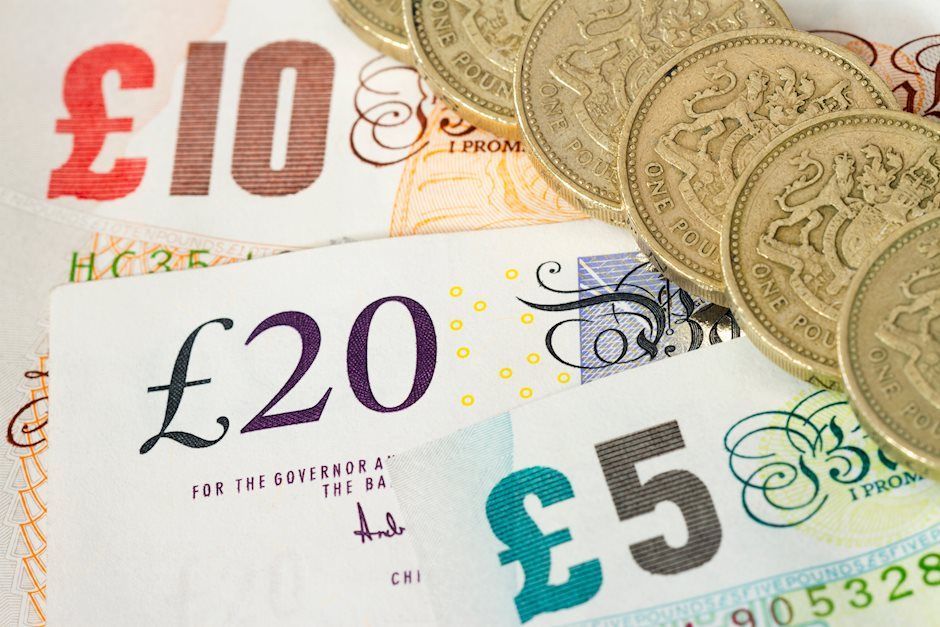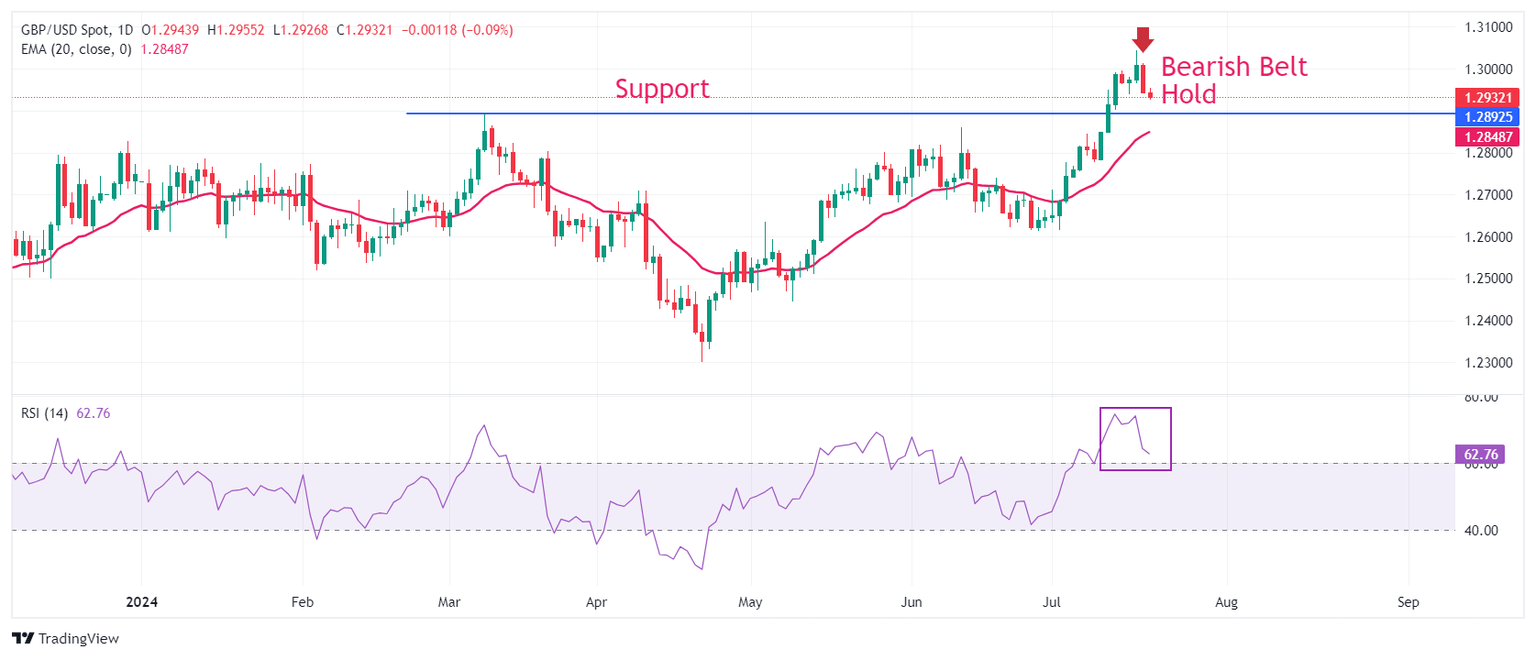Pound Sterling hits hard by sharp contraction in UK Retail Sales
- The Pound Sterling further corrects against the US Dollar after the release of weaker-than-expected UK Retail Sales data for June.
- Doubts over the BoE to begin reducing interest rates in August remain afloat.
- The uncertainty over the US Presidential elections improves the safe-haven appeal of the US Dollar.

The Pound Sterling (GBP) extends its correction against the majority of its peers in Friday’s New York session. The British currency slides further as the United Kingdom (UK) Office for National Statistics (ONS) has reported weaker-than-expected Retail Sales data for June.
The report showed that monthly Retail Sales contracted at a faster pace of 1.2%. Economists estimated a decline of 0.4% against 2.9% growth in May. Annually, receipts at retail stores dipped by 0.2%, which were expected to have grown at a similar pace. Every retailer saw a sharp decline in sales receipts except those who offers automotive fuel.
Retail Sales data is a key measure of consumer spending, and a sharp decline in the same suggests that households struggle to bear the burden of higher interest rates by the Bank of England (BoE). However, individuals may not find any relief from higher interest obligations amid uncertainty over BoE rate cuts in August.
BoE officials hesitate to favor a move towards policy normalization due to the sticky US core Consumer Price Index (CPI) amid stubborn inflation in the service sector.
Meanwhile, the expected deceleration in Average Earnings data for the three months ending in May, a key measure of wage growth that prompts service inflation, fails to lift expectations for BoE rate cuts in August as the current pace is still higher than what it is needed to be consistent for taming price pressures.
Daily digest market movers: Pound Sterling weakens as US Dollar gains
- The Pound Sterling weakens to near 1.2930 against the US Dollar (USD) as the latter rebounds strongly after printing a fresh almost four-month low. The US Dollar Index (DXY), which tracks the Greenback’s value against six major currencies, bounces back from 103.65 and extends recovery to nearly 104.30.
- The safe-haven appeal for the US Dollar improves amid growing speculation that United States (US) President Joe Biden could drop his re-election bid. This has prompted upside risks to political uncertainty.
- However, the recovery move in the US Dollar is less likely to last long as traders see the Federal Reserve (Fed) reducing interest rates in September as a done deal. Investors expect the Fed to cut borrowing costs twice this year instead of once, as signaled by policymakers in the latest dot plot.
- In Friday’s session, New York Fed Bank President John Williams and Atlanta Fed Bank President Raphael Bostic are lined up for speeches. Investors will focus on cues about when the Fed will start cutting interest rates.
- Meanwhile, Fed officials' confidence that inflation has returned to the path of 2% has improved due to slower-than-expected growth in the US inflation and easing labor market conditions. Recent CPI readings from June showed that annual headline and core inflation decelerated faster than expected, and monthly headline inflation declined for the first time in more than four years.
Pound Sterling Price Today:
British Pound PRICE Today
The table below shows the percentage change of British Pound (GBP) against listed major currencies today. British Pound was the strongest against the New Zealand Dollar.
| GBP | EUR | USD | JPY | CAD | AUD | NZD | CHF | |
|---|---|---|---|---|---|---|---|---|
| GBP | 0.00% | -0.15% | 0.02% | -0.10% | 0.03% | 0.15% | -0.02% | |
| EUR | -0.01% | -0.14% | -0.21% | -0.10% | 0.02% | 0.14% | -0.02% | |
| USD | 0.15% | 0.14% | -0.05% | 0.08% | 0.17% | 0.28% | 0.13% | |
| JPY | -0.02% | 0.21% | 0.05% | 0.12% | 0.24% | 0.35% | 0.19% | |
| CAD | 0.10% | 0.10% | -0.08% | -0.12% | 0.10% | 0.22% | 0.05% | |
| AUD | -0.03% | -0.02% | -0.17% | -0.24% | -0.10% | 0.11% | -0.05% | |
| NZD | -0.15% | -0.14% | -0.28% | -0.35% | -0.22% | -0.11% | -0.17% | |
| CHF | 0.02% | 0.02% | -0.13% | -0.19% | -0.05% | 0.05% | 0.17% |
The heat map shows percentage changes of major currencies against each other. The base currency is picked from the left column, while the quote currency is picked from the top row. For example, if you pick the British Pound from the left column and move along the horizontal line to the US Dollar, the percentage change displayed in the box will represent GBP (base)/USD (quote).
Technical Analysis: Pound Sterling dips after Bearish Belt Hold formation
The Pound Sterling corrects sharply to near 1.2920 against the US Dollar. The GBP/USD pair weakens as the upside stalls after printing a fresh annual high at 1.3044 on Wednesday. The Cable has formed a Bearish Belt Hold candlestick pattern on a daily timeframe, a move that generally comes after a sharp rally. However, this alone is incapable of confirming a bearish reversal.
The upward-sloping 20-day Exponential Moving Average (EMA) near 1.2850 suggests that the uptrend is intact. The 14-day Relative Strength Index (RSI) declines after turning slightly overbought and is expected to find a cushion near 60.00.
On the upside, a two-year high near 1.3140 will be a key resistance zone for the Cable. On the other hand, the March 8 high near 1.2900 will be a key support for the Pound Sterling bulls.
Fed FAQs
Monetary policy in the US is shaped by the Federal Reserve (Fed). The Fed has two mandates: to achieve price stability and foster full employment. Its primary tool to achieve these goals is by adjusting interest rates. When prices are rising too quickly and inflation is above the Fed’s 2% target, it raises interest rates, increasing borrowing costs throughout the economy. This results in a stronger US Dollar (USD) as it makes the US a more attractive place for international investors to park their money. When inflation falls below 2% or the Unemployment Rate is too high, the Fed may lower interest rates to encourage borrowing, which weighs on the Greenback.
The Federal Reserve (Fed) holds eight policy meetings a year, where the Federal Open Market Committee (FOMC) assesses economic conditions and makes monetary policy decisions. The FOMC is attended by twelve Fed officials – the seven members of the Board of Governors, the president of the Federal Reserve Bank of New York, and four of the remaining eleven regional Reserve Bank presidents, who serve one-year terms on a rotating basis.
In extreme situations, the Federal Reserve may resort to a policy named Quantitative Easing (QE). QE is the process by which the Fed substantially increases the flow of credit in a stuck financial system. It is a non-standard policy measure used during crises or when inflation is extremely low. It was the Fed’s weapon of choice during the Great Financial Crisis in 2008. It involves the Fed printing more Dollars and using them to buy high grade bonds from financial institutions. QE usually weakens the US Dollar.
Quantitative tightening (QT) is the reverse process of QE, whereby the Federal Reserve stops buying bonds from financial institutions and does not reinvest the principal from the bonds it holds maturing, to purchase new bonds. It is usually positive for the value of the US Dollar.
Author

Sagar Dua
FXStreet
Sagar Dua is associated with the financial markets from his college days. Along with pursuing post-graduation in Commerce in 2014, he started his markets training with chart analysis.


















